Document 13309448
advertisement
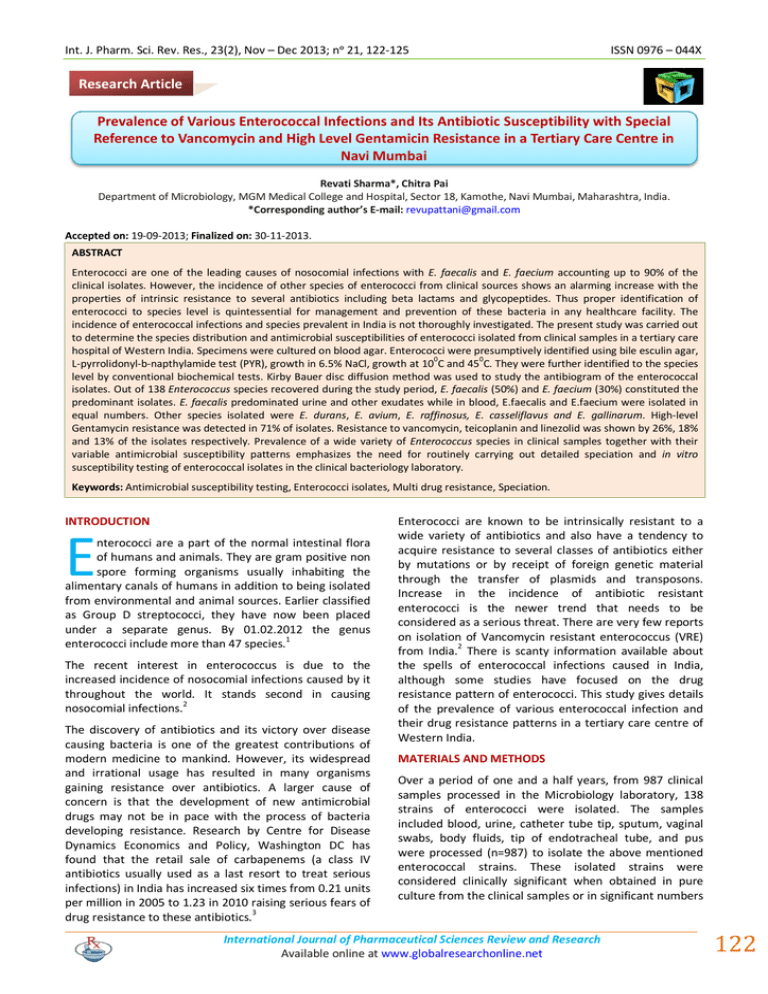
Int. J. Pharm. Sci. Rev. Res., 23(2), Nov – Dec 2013; nᵒ 21, 122-125 ISSN 0976 – 044X Research Article Prevalence of Various Enterococcal Infections and Its Antibiotic Susceptibility with Special Reference to Vancomycin and High Level Gentamicin Resistance in a Tertiary Care Centre in Navi Mumbai Revati Sharma*, Chitra Pai Department of Microbiology, MGM Medical College and Hospital, Sector 18, Kamothe, Navi Mumbai, Maharashtra, India. *Corresponding author’s E-mail: revupattani@gmail.com Accepted on: 19-09-2013; Finalized on: 30-11-2013. ABSTRACT Enterococci are one of the leading causes of nosocomial infections with E. faecalis and E. faecium accounting up to 90% of the clinical isolates. However, the incidence of other species of enterococci from clinical sources shows an alarming increase with the properties of intrinsic resistance to several antibiotics including beta lactams and glycopeptides. Thus proper identification of enterococci to species level is quintessential for management and prevention of these bacteria in any healthcare facility. The incidence of enterococcal infections and species prevalent in India is not thoroughly investigated. The present study was carried out to determine the species distribution and antimicrobial susceptibilities of enterococci isolated from clinical samples in a tertiary care hospital of Western India. Specimens were cultured on blood agar. Enterococci were presumptively identified using bile esculin agar, 0 0 L-pyrrolidonyl-b-napthylamide test (PYR), growth in 6.5% NaCl, growth at 10 C and 45 C. They were further identified to the species level by conventional biochemical tests. Kirby Bauer disc diffusion method was used to study the antibiogram of the enterococcal isolates. Out of 138 Enterococcus species recovered during the study period, E. faecalis (50%) and E. faecium (30%) constituted the predominant isolates. E. faecalis predominated urine and other exudates while in blood, E.faecalis and E.faecium were isolated in equal numbers. Other species isolated were E. durans, E. avium, E. raffinosus, E. casseliflavus and E. gallinarum. High-level Gentamycin resistance was detected in 71% of isolates. Resistance to vancomycin, teicoplanin and linezolid was shown by 26%, 18% and 13% of the isolates respectively. Prevalence of a wide variety of Enterococcus species in clinical samples together with their variable antimicrobial susceptibility patterns emphasizes the need for routinely carrying out detailed speciation and in vitro susceptibility testing of enterococcal isolates in the clinical bacteriology laboratory. Keywords: Antimicrobial susceptibility testing, Enterococci isolates, Multi drug resistance, Speciation. INTRODUCTION E nterococci are a part of the normal intestinal flora of humans and animals. They are gram positive non spore forming organisms usually inhabiting the alimentary canals of humans in addition to being isolated from environmental and animal sources. Earlier classified as Group D streptococci, they have now been placed under a separate genus. By 01.02.2012 the genus enterococci include more than 47 species.1 The recent interest in enterococcus is due to the increased incidence of nosocomial infections caused by it throughout the world. It stands second in causing nosocomial infections.2 The discovery of antibiotics and its victory over disease causing bacteria is one of the greatest contributions of modern medicine to mankind. However, its widespread and irrational usage has resulted in many organisms gaining resistance over antibiotics. A larger cause of concern is that the development of new antimicrobial drugs may not be in pace with the process of bacteria developing resistance. Research by Centre for Disease Dynamics Economics and Policy, Washington DC has found that the retail sale of carbapenems (a class IV antibiotics usually used as a last resort to treat serious infections) in India has increased six times from 0.21 units per million in 2005 to 1.23 in 2010 raising serious fears of drug resistance to these antibiotics.3 Enterococci are known to be intrinsically resistant to a wide variety of antibiotics and also have a tendency to acquire resistance to several classes of antibiotics either by mutations or by receipt of foreign genetic material through the transfer of plasmids and transposons. Increase in the incidence of antibiotic resistant enterococci is the newer trend that needs to be considered as a serious threat. There are very few reports on isolation of Vancomycin resistant enterococcus (VRE) from India.2 There is scanty information available about the spells of enterococcal infections caused in India, although some studies have focused on the drug resistance pattern of enterococci. This study gives details of the prevalence of various enterococcal infection and their drug resistance patterns in a tertiary care centre of Western India. MATERIALS AND METHODS Over a period of one and a half years, from 987 clinical samples processed in the Microbiology laboratory, 138 strains of enterococci were isolated. The samples included blood, urine, catheter tube tip, sputum, vaginal swabs, body fluids, tip of endotracheal tube, and pus were processed (n=987) to isolate the above mentioned enterococcal strains. These isolated strains were considered clinically significant when obtained in pure culture from the clinical samples or in significant numbers International Journal of Pharmaceutical Sciences Review and Research Available online at www.globalresearchonline.net 122 Int. J. Pharm. Sci. Rev. Res., 23(2), Nov – Dec 2013; nᵒ 21, 122-125 as part of mixed cultures. The isolates were further identified as follows, I. Presumptive identification Samples were cultured on to 5 % blood agar and Mac Conkeys agar. Gram positive cocci showing negative catalase reaction, positive PYR test, black colonies on bile esculin agar and growth in 6.5% NaCl broth were presumptively identified as enterococci. Further, growth of the isolates at both 40C and 450C temperature confirmed them to be enterococci. Bacitracin sensitivity was also done to exclude other Streptococcus species II. ISSN 0976 – 044X (13%) from sputum, 14 (10.1%) each from blood and catheter tip and 5(4%), 4(3%), 3(2%), 1(0.7%) from endotracheal tip, peritoneal fluid, cerebrospinal fluid, and vaginal swabs respectively. Of the total 138 persons from whom the strains were isolated, 57.5% were from males and 42.5% were females including newborns and children. Maximum number of enterococcal strains was isolated from urine samples (n=51). The distribution of enterococcal strains isolated from various specimens is given in figure 1. Characterization and speciation of the isolates The isolates which were primarily identified as enterococcus were then further characterized to the species level with the help of conventional biochemical 4 methods as devised by Faclam and Collins. This was based on, a. b. c. d. e. Fermentation of the carbohydrates by using 1% solution of the sugars, glucose, lactose, raffinose, arabinose, sorbose, sucrose and sorbitol. Pyruvate utilization using 1% pyruvate slant. Arginine decarboxylation using Moellers decarboxylation broth. Motility test. Pigment production using nutrient agar. For these biochemical tests, a single colony was picked and inoculated in brain heart infusion broth and incubated at 370C for 24 hrs. This was then used as an inoculum for the above tests. All the tests were incubated at 370C and read at 24 hrs. III. Antibiotic susceptibility testing (AST) The isolates were tested for their susceptibility to antibiotics using disk diffusion method in accordance with CLSI guidelines 2002.5 The isolates were grown overnight in brain heart infusion broth, adjusted to a 0.5 turbidity reading on McFarland scale which is approximately equal to 1.5 x 108 bacteria / mL. It was then used to inoculate on Mueller Hinton agar plates. Inoculation was done with the help of sterile swabs which was brushed across the medium. Disks containing the following antibiotics at a specific concentrations were used, vancomycin (30µg), Ampicillin + Sulfabactum, AS (20ug), Cotrimoxazole, BA (25ug), Ciprofloxacin RC (5ug), Cephalexin PR (30ug), Cefotaxime CF (30ug), Gentamycin GM (10 µg), Tetracyclin TE (30ug), Linezolid LZ (30ug), levofloxacin QB (5ug), Roxithromycin AT (15ug), Teicoplanin Te (30ug). The strains were also screened for high level Gentamycin (HLG) resistance using HLG disc (120 µg). The performance and reading of the tests were quality controlled by Enterococcus faecalis ATCC 29212. RESULTS AND DISCUSSION A total of 138 enterococcal strains were isolated from different clinical samples. 51 strains (37%) of enterococci were isolated from urine samples, 28 (20%) from pus, 18 Figure 1: Isolation of various enterococci strains from different clinical samples. Table 1: Isolation of various species of enterococcus as identified by the test scheme. Enterococcus species Percentage (%) Enterococcus faecalis 50 Enterococcus faecium 30 Enterococcus avium 7 Enterococcus raffinosus 4 Enterococcus casseliflavus 4 Enterococcus durans 4 Enterococcus gallinarum 1 The isolates were identified according to the test scheme as mentioned above (Table 1). The most predominant species identified was Enterococcus faecalis (n= 69, 50%) followed by Enterococcus faecium (42, 30%). 27 cases (20%) of unusual species of enterococci (non faecalis and non faecium) were identified which included; E.avium (9, 7%), E.raffinosus (6, 4%), E.casseliflavus (5,4%), E.durans (5,4%), E.gallinarum (2,1%), E.faecalis was further subspeciated and it was found that amongst the E.faecalis strains, E.faecalis var.liquefaciens (29, 42%) was the most prevalent followed by E.faecalis var. haemolyticus (13,19%), and E.faecalis var. zymogens (5,7%). E.faecalis outnumbered the other enterococcus spp in all the samples except in case of blood samples where E.faecalis and E.faecium were isolated in equal proportion as well as in catheter tip specimens where E.faecium was isolated in higher percentage than E.faecalis. (Refer Table 2) International Journal of Pharmaceutical Sciences Review and Research Available online at www.globalresearchonline.net 123 Int. J. Pharm. Sci. Rev. Res., 23(2), Nov – Dec 2013; nᵒ 21, 122-125 ISSN 0976 – 044X Table 2: Frequency of enterococci isolates obtained from various clinical specimens No of isolates Clinical Samples E.faecalis E.faecium E.avium E.raffinosus E.casseliflavus E.durans E.gallin-arum Total Urine 29 (57%) 17(33%) 0(0%) 1(2%) 2 (4%) 2(4%) 0(0%) 51 (37%) Blood 6 (43%) 6 (43%) 1 (7%) 0 1(7%) 0 0 14 (10%) Catheter tip 3 (21%) 5 (35%) 2 (14%) 3 (21%) 0 1 (7%) 0 14 (10%) Endotracheal tube 4 (80%) 0 0 0 0 1 (20%) 0 5 (4%) Pus 11 (39%) 8 (29%) 3 (11%) 1 (4%) 2 (7%) 1 (4%) 2 (7%) 28 (20%) Vaginal Swab 0 1 (100%) 0 0 0 0 0 1(0.7%) CSF 3 (100%) 0 0 0 0 0 0 3 (2.1%) Pericardial fluid 2 (50%) 1 (25%) 1 (25%) 0 0 0 0 4(3%) Sputum 11 (61%) 4 (22%) 2 (11%) 1(6%) 0 0 0 18(13%) Total 69 (50%) 42 (30%) 9 (7%) 6 (4%) 5 (4%) 5 (4%) 2 (1%) 138 Table 3: Antimicrobial susceptibility pattern of enterococci isolates Isolates antimicrobial agent E.faecalis E.faecium E.avium E.raffinosus E.casseliflavus E.durans E.gallinarum Ampicillin+Sulbactum (AS) 41 (60.8%) 24 (57%) 6 (67%) 1 (17%) 5(100%) 3 (60%) 0 Co- trimoxazole (BA) 24 (34.7%) 17 (40%) 3 (33%) 0 3 (60%) 3 (60%) 2(100%) Ciprofloxacin (RC) 26 (37.6%) 19 (45%) 5 (55%) 0 1 (20%) 4 (80%) 2(100%) Cefotaxime (CF) 19 (27.5%) 14 (33) 4 (44%) 1 (17%) 0 1(20%) 2(100%) Tetracycline (TE) 29 (42%) 19 (45%) 6 (67%) 2 (33%) 1 (20%) 3 (60%) 2(100%) Cephalexin (PR) 21 (30.4%) 10 (24%) 5 (55%) 0 3 (60%) 2 (40%) 0 Roxythromycin (AT) 24 (34.7%) 9 (21%) 5 (55%) 1 (17%) 4 (80%) 1 (20%) 0 Levofloxacin (QB) 30 (43.4%) 18 (43%) 3 (33%) 1 (17%) 5 (100%) 1 (20%) 2(100%) Vancomycin (V) 54 (78.2%) 33 (79%) 3 (33%) 2 (33%) 4 (80%) 4 (80%) 2(100%) Teicoplanin (Te) 59 (85.5%) 29 (69%) 9 (100%) 5 (83%) 4 (80%) 4 (80%) 2(100%) Linezolid (LZ) 60 (86.9%) 37 (88%) 8 (88%) 6 (100%) 4 (80%) 5 (100%) 0 Antibiotic susceptibility pattern The susceptibility pattern of all the enterococci spp to different antibiotics is as shown in Table 3. Phenomenon of multi drug resistance was observed in all the strains isolated. Maximum susceptibility pattern was observed with, linezolid (86%) followed by teicoplanin (81%) and vancomycin (74%), ampicillin + sulbactum (58%). The susceptibility to other drugs was below 50%. The isolates were most resistant to cephalexin and cefotaxime 70% each. All the species showed maximum susceptibility to linezolid except for E.avium and E.gallinarum which was maximally susceptible to teicoplanin. Among the vancomycin resistant strain, 11 isolates belonged to the VAN A phenotype while 12 isolates were in the VAN B phenotypic group. Urinary isolates (69%) of enterococci showed the maximum resistances to all the antibiotics followed by the isolates from blood (51%) and pus (48%). It was observed that E. faecium showed more resistance to vancomycin (21%) and teicoplanin (31%) and as compared to that shown by E.faecalis (20% and 14%). 71% of the enterococci isolates were high level Gentamycin resistant strains out of which 33 % were E.faecalis, 30 % E.faecium and rest 8% were other enterococci spp. Enterococci are the second most leading cause of nosocomial infection in the list of most prevalent pathogens, according to a report by CDC.6 A cause of concern is its increasing resistance to various antimicrobial agents making it a notorious pathogen for several life threatening infections. This study utilized a test scheme devised by Faclam and Collins to identify and speciate various enterococci spp. In our opinion, this key scheme was able to identify all the 138 strains of which is very similar to a study conducted by Desai et al.7 who could identify all their 202 enterococci isolates with the mentioned scheme. However this was not the case with several other workers like Buschelam et al and Ruoff et al had difficulties in identifying enterococci spp using the key tests of this 8,9 scheme. While reporting the pathogenic organism, many of the laboratories do not identify the enterococci isolates up to the species level. Even though 80-90% of the enterococcal infections are caused by E.faecalis and E.faecium, there are reports from several parts of the world that there is International Journal of Pharmaceutical Sciences Review and Research Available online at www.globalresearchonline.net 124 Int. J. Pharm. Sci. Rev. Res., 23(2), Nov – Dec 2013; nᵒ 21, 122-125 ISSN 0976 – 044X an alarming increase in the incidence of the other species of enterococci with intrinsic resistance to several classes of antibiotics. The prevalence of the unusual species of enterococci in our clinical set up is 20% which is a major finding as many other studies and reviews have reported the prevalence of non faecalis and non faecium enterococci as only 2 – 10%.10, 11 Previous studies from India have reported E.faecalis and E.faecium as the only species of enterococci prevalent in India which may not 10, 12, 13 be the true scenario. REFERENCES 1. Brtkova A, Filipova M, Drahovska H, Bujdakova H, Characterization of enterococci of animal and environmental origin using phenotypic methods and comparison with PCR based methods, Veterinarni Medicina, 55(3), 2010, 97–105. 2. Karmarkar MG, Edwin SG, Mehta PR, Enterococcal infections with special reference to phenotypic characterization & drug resistance, Indian J Med Res, 119 (Suppl), May 2004, 22-25. In the current study all the enterococci spp isolated from the clinical specimen were multidrug resistant. Also, a large proportion of the isolates showed high level Gentamycin resistance, which is a cause of great concern because enterococcal infections are traditionally being treated with combination of cell wall active agents like penicillin or ampicillin and amino glycosides like Gentamycin. The emergence of HLGR enterococci that too in such a high proportion has jeopardized the synergistic effect of beta lactams and amino glycosides thus limiting the therapeutic options for treating enterococcal infections. Resistance to high level aminoglycoside has led to the usage of vancomycin as the drug of choice. However our study has reported a good percentage of isolates to be vancomycin resistant as well. There should be a constant screening for vancomycin resistant enterococci (VRE) as there are recent reports of sporadic isolates being vancomycin resistant.13 Linezolid and teicoplanin have shown a good anti enterococcal effect and hence can be used as a second line drug of choice for VRE. E.faecium showed a higher level of resistance to all the antibiotics than E.faecalis. 3. http://articles.timesofindia.indiatimes.com/2012-0514/india/31700502_1_doripenem-antibiotics-ertapenem. 4. Facklam RR, Collins MD, Identification of enterococcus species isolated from human infection by a conventional test scheme, J Clin Microbiol, 27, 1989, 731-734. 5. National Committee for Clinical Laboratory Standards Performance standards for antimicrobial disk susceptibility testing;Twelfth informational supplement (M 100-S12), 2002, Wayne PA:NCCLS, 2002. 6. Centres for Disease Control, Nosocomial enterococci resistant to vanomycin: United States, 1989-1993: National Nosocomial Infection Surveilance, MMWR, 42, 1993, 597 599. 7. Desai PJ, Pandit D, Mathur M, Gogate A, Prevalence, Identification and distribution of various species of enterococci isolated from clinical specimens with special reference to urinary tract infections in catherized patients, Indian J of Med Microbiol, 19(3), 2001, 132-137. 8. Buschelmann BJ, Bale MJ, Jones RN, Species identification and determination of high-level aminoglycoside resistance among enterococci, Diagn Microbiol Infect Dis, 16, 1993, 119-122. Regarding the antimicrobial susceptibility of unusual enterococci, E. raffinosis showed a very high resistance (100% resistance to BA, RC, PR) to all the antibiotics but was 100% susceptible to linezolid. These unusual species showed higher resistance to all antibiotics as compared to E.faecalis and E.faecium. 9. Ruoff KL, Maza L, Murtagh MJ, Species identities of enterococci isolated from clinical specimens, J Clin Microbial, 28, 1990, 435 - 437. CONCLUSION Our study indicates emergence of unusual species of enterococci and a change in the epidemiology of enterococcal infections in Western India. There is a need to study the prevalence of enterococcal species to reflect the exact local situation in different parts of our country. Also we emphasize the need to design or find new drugs against enterococci spp due to their dynamic multi drug resistance nature. A constant monitoring of antibiotic resistant patterns and measures undertaken to avoid the spread of drug resistant isolates of enterococci will be important steps in tackling nosocomial infections as well as community acquired enterococcal infections which are refractory to therapy. 10. Gordon S, Swenson JM, Hill BC, Pigott NE, Facklam RR, Cooksey RC, et al, Antimicrobial susceptibility patterns of common and unusual species of enterococci causing infections in the United States, Enterococcal Study Group, J Clin Microbiol, 30, 1992, 2373-2378. 11. Murray BE, Diversity among multidrug-resistant enterococci, Emerg Infect Dis, 4, 1998, 37-47. 12. Facklam RR, Sahm DF, Texeira LM, Enterococcus. In: Murray PR, Baron EJ, Pfaller MA, Tenover FC, Yolken RH, editor. Manual of clinical microbiology, ASM press, Washington, DC, 1999, 297–305. 13. Jones RN, Sader HS, Erwin ME, Anderson SC, Emerging multiply resistant enterococci among clinical isolates, Prevalence data from 97 medical center surveillance study in the United States. Enterococcus Study Group, Diagn Microbiol Infect Dis, 21, 1995, 85–93. doi: 10.1016/07328893(94)00147-O. Source of Support: Nil, Conflict of Interest: None. International Journal of Pharmaceutical Sciences Review and Research Available online at www.globalresearchonline.net 125
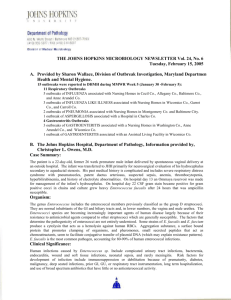
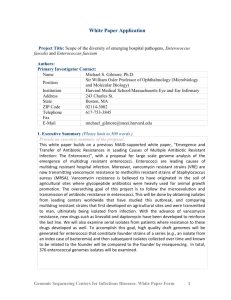
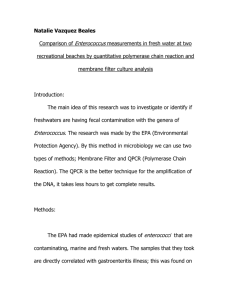

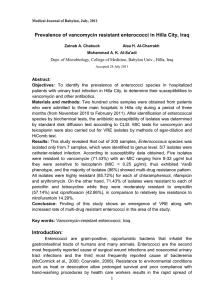
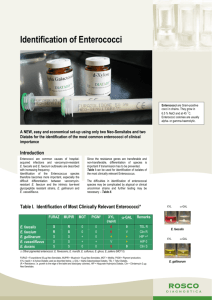
![medicine3_33[^]](http://s3.studylib.net/store/data/007298585_1-a62be5f279aa0f8ef6282c4c51ca07b8-300x300.png)
